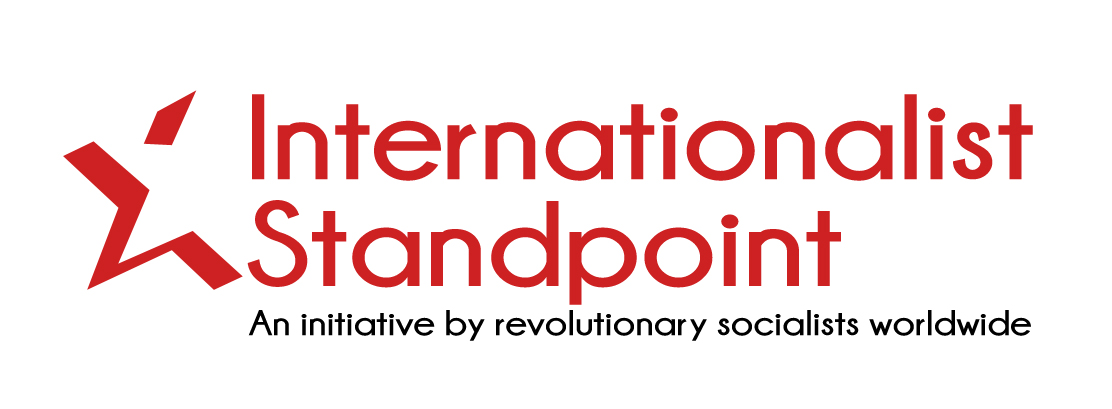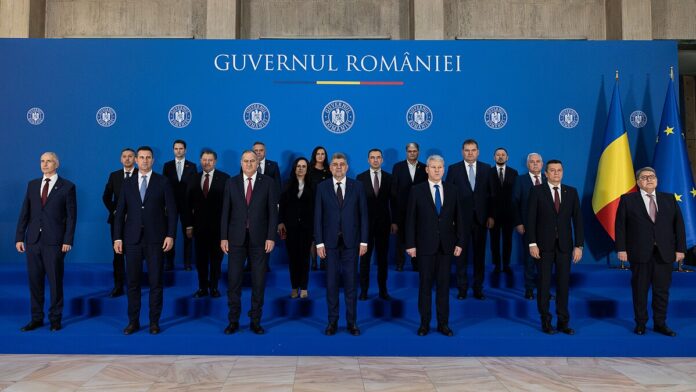by A.D.
After an electoral campaign in which the bourgeois parties and their candidates competed with pathetic promises and mutual accusations of corruption, incompetence, and even “national treason,” the resulting governing coalition—formed by PSD (Social Democrats), PNL (National Liberals), UDMR (Democratic Alliance of Hungarians in Romania), and national minority parliamentarians—managed to put together an executive led by Marcel Ciolacu. Less than a week after his inauguration, he had already become known for a very unpopular measure, nicknamed, somewhat ironically, the “Little Train Ordinance”.
Collapse of public trust
PSD and PNL are in free fall in terms of public trust—but that’s only half the story. The temporary coalition that PSD and PNL decided to form after the lamentable collapse of the liberal PNL-UDMR-USR (Save Romania Union) coalition severely limited their freedom of action, reducing them to mere administrators of the state and representatives of international institutions. This situation has led parts of the social forces (factions of the bourgeois class) that had previously supported these parties—but are now increasingly disadvantaged by the fragile architecture of public-private partnerships and free trade policies of the European Union—to reorient themselves toward other parties that can better represent their interests. In this case, the favored political formations are the sovereigntist ones, primarily AUR (Alliance for the Union of Romanians).
This shift was also evident in the parliamentary elections (December 1, 2024) and in the first round (November 24, 2024) of the presidential elections (and most likely would have been confirmed in the second round, had it been allowed to take place), when entire electoral districts that had strongly supported PSD and PNL in previous years abandoned these parties in favor of Călin Georgescu and AUR. These developments confirm that the social forces that once mobilized the electorate in favor of PSD and PNL have now switched sides.
Despite its growing popularity, AUR failed to form a governing coalition around itself, and power remained in the hands of PSD and PNL—this time in a much weaker coalition with far less parliamentary stability. However, while the leaders of these parties (both former and current) have expressed only criticism toward AUR and its leader George Simion, the Ciolacu 2 government program seems to tell a different story—one that reveals how similar the current trends of Romanian parties actually are. This should come as no surprise, and cannot be blamed on “political will” or other explanations that mystify the nature of the bourgeois state. It is instead a consequence of the current drive toward protectionism, tariffs, and investments in fixed and productive capital. Political parties (speaking here only of bourgeois parties) are not independent actors; they are representatives of certain strata of the bourgeois class and must respond to their specific needs for capital accumulation.
Left criticisms
Several organizations on the Romanian left rushed to criticize the “Little Train” emergency ordinance, competing in superficial explanations and concerns. For example, SENS, a new petit-bourgeois leftist party in Romania, considered the most important point of critique to be the “allegations” that the government intended to pass an emergency ordinance eliminating the possibility for companies to redirect part of their profit tax to NGOs. Other organizations simply criticized austerity, interpreting it as a matter of “political will.”
These criticisms—often coming from individuals and organizations that, at least rhetorically, consider themselves anti-capitalist—do nothing more than reaffirm a liberal understanding of how capitalism works. In reality, if the “political will” does not aim to overcome capitalism (which we cannot expect from a bourgeois party), then it can only operate within its limits. Under capitalism, the reproduction of society depends on the reproduction of capital. The Ciolacu 2 government does nothing more than identify historical necessities of capital accumulation and implement them. In fact, compared to other parties, the current executive’s program includes more benefits for the popular classes, indicating some left-leaning economic intentions—within the limits of what a government of a semi-peripheral bourgeois state can implement. Mere criticism of Ciolacu and his supposed intentions only reinforces the illusion that capitalism can serve the working class, if only the state were led by people with “pure” motives—which is, obviously, false.
Context
Therefore, any critique that seeks to go beyond simple opposition to austerity must be historically contextualized. The Ciolacu 2 government program begins with several measures aimed at reducing state bureaucracy. This will supposedly be achieved by merging or abolishing certain agencies, institutions, or state-owned enterprises, depending on the outcome of an efficiency audit. The government also aims to reduce the number of ministries in the central administration from 25 to 16. PSD is also working on a regionalization project, in which small localities will be merged, and Romania’s territorial division into counties will be replaced by much larger regions, with the goal of reducing the state apparatus. The consequence of these measures will be that a significant number of public administration employees will lose their jobs, increasing the industrial reserve army in Romania. Although the program claims to invest in disadvantaged communities in small towns, the only actual “aid” it has offered so far is to accelerate migration from rural to urban areas and help capital access a labor force that it would otherwise have struggled to mobilize.
The next point in the program is titled “Fiscal-budgetary consolidation reforms.” The measures mentioned here—including the gradual reduction of taxes and labor-related contributions by 5%, the exemption of students who work during their studies from healthcare taxes, the introduction of tax breaks for poor families, and the promotion of “active aging” by exempting pensioners from healthcare and social security taxes after the mandatory contribution period—are strongly reminiscent of the AUR program, which proposed similar, even more radical, measures, particularly regarding pensioners, who would have paid no taxes at all after the mandatory contribution period.
“Active aging”
Behind the appealing language of “active aging,” which aligns nicely with AUR’s slogan “we support Romania’s seniors,” we can see the real objective: integrating as many layers of society as possible into the process of capital accumulation. This inevitably leads to a weakening of workers’ bargaining power and, consequently, a decrease in the price of labor. The true image is that of an exhausted labor force, forced to work itself to death for the sake of an “industrial revival of Romania.” We thus see the similarities between the policies promoted by a self-proclaimed sovereignist party and a social-democratic party, with the differences reduced mainly to the degree of harshness in the measures.
The section titled “Industrial Renaissance through Productivism – a model of economic growth based on investments, state aid schemes and guarantees” begins almost like a PowerPoint slide from a McKinsey presentation: “Romania, technological and industrial hub in Eastern Europe.” The Ciolacu government envisions 155 billion euros in public investments over the next five years, focused on transport infrastructure, the environment, education, healthcare, technology, and competitive industries. Ten billion euros would be directed toward state aid schemes for investments and guarantees in high-tech industries and ad hoc state support, covering sectors such as the automotive, chemical, pharmaceutical, food, and metallurgical industries, as well as construction materials, defense, and energy. The program continues with a section explaining “economic patriotism.”
The government plans to provide grants worth 25% for greenfield investments over 150 million euros in the “manufacturing industry, generating well-paid jobs.” Large energy and gas companies are envisioned as becoming “regional champions.” The investment programs would be expanded to “encourage lending in strategic industrial sectors and to companies with a strong export component.” All these measures culminate in the final part of the section, which makes the ultimate goal clearer: a “Program to support the internationalization of Romanian companies through guarantee schemes for expanding presence in regional markets, including the construction or acquisition of new production capacities.”
Economic patriotism
In reality, this “economic patriotism” is nothing more than an acknowledgment of Romania’s current position in the global division of labor and an attempt—more or less feasible—to renegotiate that position through the development of productive capital. Much like AUR’s platform, the proposal is framed in corporatist terms, presenting these measures as generators of “well-paid jobs,” thereby transforming the class conflict into a conflict between peoples—in this case, the Romanian people versus their regional neighbors. The program also openly acknowledges the need for capital export, promoting “regional champion” companies as instruments of Romanian imperialism.
The program already aims to increase the employment rate by tapping into human resources from age categories that have not been fully accessed until now. However, retirees often constitute a labor force that is too exhausted for many types of work, and students represent a relatively small demographic segment in Romania. To fill this gap, the program includes pro-natalist measures. Women would benefit from increased support and professional assistance and will be encouraged to return to work more quickly. Romania currently offers one of the most generous maternity leaves in Europe—two years, with 80% of the salary paid during this period. However, in order to meet the requirements for joining the OECD (and to avoid leaving poor Romanian employers without a labor force to exploit), Romania plans to shorten the length of maternity leave. The government also promises to support employers in creating special spaces for preschool-aged children within enterprises, and to build nurseries with extended hours, open until 6pm Children would receive increased allowances and a “13th allowance.”
The government continues with a promise to build 100,000 social housing units, to be offered primarily to young couples and young families with children, explicitly for the purpose of “demographic revitalization.” Once again, the bourgeois parties show that struggles around specific issues—such as social housing—are not at all incompatible with capital, when divorced from class struggle, and can even become momentary necessities, recognized by any bourgeois state in light of capital’s difficulties in reproducing the labor force.
Regarding energy production, the government assumes responsibility for operationalizing the Neptun Deep project and exploiting other natural gas reserves. The program also mentions investments in nuclear energy, including modular nuclear reactors. Following Donald Trump’s official inauguration (where he pompously declared “we will drill, baby, drill”), the Romanian Minister of Energy, Sebastian Burduja, responded by declaring that “The EU’s green policies, although well-intentioned, are not a path to prosperity,” and that “We are protecting the environment in vain if we are heading towards economic collapse.” Electricity production is a precondition for industrial development, and if the executive promotes industrialisation, it must increase energy production capacity. However, it is doing so in a way that relegates climate change to a secondary concern, promising instead well-paid jobs and lower prices per gigawatt-hour. The government also pledges to modernize the national defense industry, aiming to “transform it into a pillar of economic growth through strategic investments, international collaborations, and the development of advanced technologies.” It commits to continuing investments made last year, such as the modernization of the Cugir Mechanical Plant.
Austerity and productivism
The “Little Train Ordinance” is therefore nothing more than the first step in this broader program. The government is proposing austerity measures to unlock funds that could then be redirected toward “productivism” and “economic patriotism”—concepts Ciolacu had been promoting since the beginning of his term in 2023, and which he presents in an extraordinarily appealing manner.
Thus, many categories of state employees would either be fired—through the elimination of their positions or even the abolition of entire institutions—or have their incomes significantly reduced, through cuts to bonuses, annual premiums, and overtime pay (which would most often be compensated with time off). Teachers, who were promised salary increases in two installments, saw their promise crumpled and thrown into the waste bin of capital’s deceitful assurances. Bucharest metro workers had their promised wage increase cut. The measure to eliminate vacation vouchers was reversed only after HoReCa employers warned that they would be negatively affected. In other words, we see once again that a government formed by bourgeois parties represents the interests of the capitalist class.
The question remains: what is the working class doing in this context?
Working class response
Shortly after the announcement of the emergency ordinance, several trade union organizations reacted. Cartel Alfa, in a press release, declared that “the decision-makers did not understand the message of the citizens in the parliamentary elections, through which they sanctioned: the lack of communication, the lack of transparency, the lack of focus of the political decision-makers on the priorities of the citizens, and not on their personal and group priorities, the lack of respect of the decision-makers for the laws of the country, which in their view are made for ordinary citizens, not for themselves.” Their proposal is that the government should adopt any measures only after consulting with the unions, employers, and civil society.
Cartel Alfa simply criticizes the lack of transparency with which the government adopted this decision, and the privileges enjoyed by certain layers of the public administration—privileges that, in their view, should have been the first to be cut. The blame is laid on a certain “political class” perceived as responsible for the current situation. The press release ends with: “It is time for decision-makers to understand that the economy is not an end in itself, but a means to create a better society for people.” With this exhortation, the Cartel Alfa leadership takes on a typical role within bourgeois society: acting as a counterweight to the excesses of state measures without questioning the continued existence of the bourgeois state itself—a position that ultimately serves to reproduce the workforce and bourgeois society.
Once again, the Little Train Ordinance is framed as a matter of “political will,” rather than as the result of historical and structural needs within a bourgeois administration. This approach is also visible in the majority of responses from other trade union organizations (in education, transport, and even from the IT workers’ union in Timișoara). That is, opposition arises only when their specific segment of paid work is affected, with no sign of solidarity among workers in different sectors of production or social reproduction. This is partly due to Romanian legislation, which encourages the corporatist organization of trade unions, but it is also a reflection of the fact that the working class has not yet developed a class consciousness correspondent with the objective situation. In this context, the only demands being made are either strictly economic or reflect a limited understanding of their structural position in society.
The working class in Romania must form a party through which it can represent its interests and wage the struggle against capital. But how can it get there? When the working class is not yet militant enough to collectively engage in struggle against capital, the task of socialists/communists is to support and encourage opposition—even if imperfect—to the policies of the bourgeoisie, and to infuse that struggle beyond immediate economic demands (such as wage increases) or narrow political demands that remain within the framework of bourgeois society (such as calls for respecting collective labor agreements or maintaining “social dialogue”). These struggles have no alternative but to be politicized, and patient work should be done inside the working class so the “political class” is not seen as the only enemy—a framing that opportunists can easily co-opt—and toward popularising the concept that capital is the root cause of their exploitation and misery.
In the context of the Little Train Ordinance, the historical moment we are living through, and the policies described in this article, such politicization could take the form of organized opposition to the promised investments in sectors like the arms industry or hydrocarbon exploitation—areas which, no matter what wages or benefits they might provide, do not serve the interests of the working class. And this struggle must not be reduced to opposition to one policy or another, but must lead to the understanding that the capitalist mode of production cannot emancipate the working class. The only real solution is to overthrow it.



